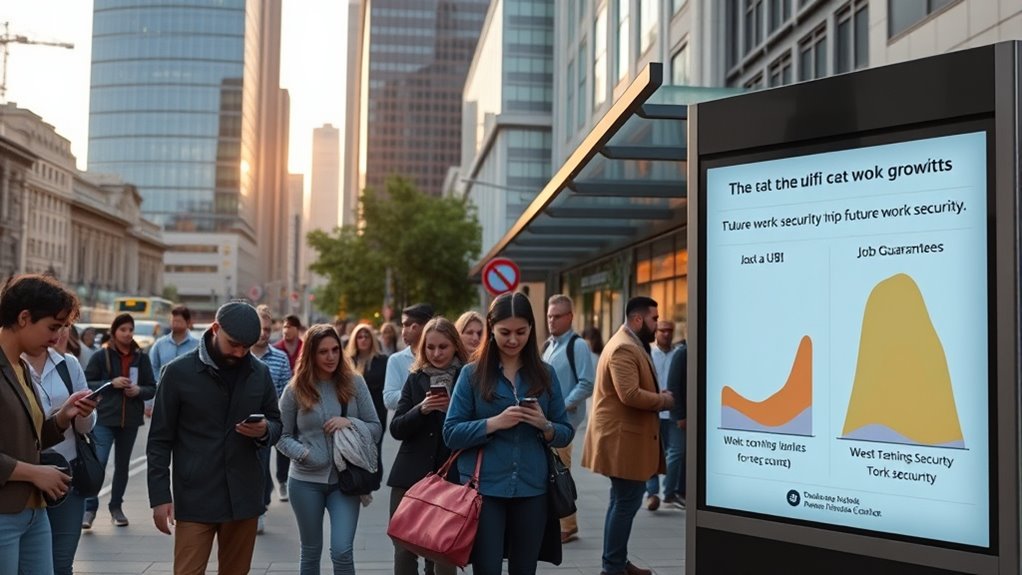If you’re wondering which approach secures future work, consider that Universal Basic Income offers income security and simplifies welfare, but may reduce work incentives. Job Guarantees create immediate employment and skill-building, shaping a stable economy. Both have strengths and challenges, but understanding their societal, economic, and technological impacts can guide your view. Keep exploring to discover ways these ideas might shape the future of work and your role within it.
Key Takeaways
- UBI provides income security universally, fostering entrepreneurship and economic stability, but may reduce work incentives without targeted employment.
- JG directly creates jobs, ensuring active workforce participation, skill development, and community benefits for long-term economic resilience.
- UBI is costly and requires sustainable funding, while JG’s ongoing expenditure aligns with employment generation and infrastructure projects.
- Combining both policies can balance income security with employment opportunities, enhancing adaptability in future work environments.
- The future of work depends on flexible, integrated approaches that address automation, inequality, and changing labor market demands.
Comparing the Core Objectives of UBI and Job Guarantee

When comparing the core objectives of Universal Basic Income (UBI) and Job Guarantee (JG), it’s clear that each approach aims to address income security and poverty reduction differently. UBI provides a fixed cash payment to all citizens, offering supplemental income regardless of employment status, but often falls short of fully meeting basic needs. JG, on the other hand, creates direct employment opportunities at or above the poverty line, raising earned income and offering work-related benefits like health and pensions. While both reduce poverty, JG tends to do so more quickly and sustainably by increasing actual earnings and linking income to work. public employment programs associated with JG can foster community development and skill-building that contribute to long-term economic resilience. Additionally, these programs can serve as a foundation for building local infrastructure and supporting community-led initiatives that enhance social cohesion. Moreover, integrating self-reflection and assessment techniques can help optimize the effectiveness of these programs for individual and community growth, especially considering the role of AI-driven data analytics in improving program outcomes. Recognizing the importance of comprehensive planning can further enhance the sustainability and impact of these initiatives.
Addressing Poverty and Unemployment Through Policy Choices

You can choose policies like Universal Basic Income or job guarantee programs to tackle poverty and unemployment directly. UBI offers income security and economic stimulus, while job guarantees provide stable employment and skill development. Understanding how each approach affects vulnerable populations and economic stability helps you make informed policy decisions. Incorporating green technologies into employment strategies can further enhance sustainability and long-term economic resilience.
Poverty Reduction Strategies
How can policy choices effectively reduce poverty and unemployment? Implementing direct financial support like Universal Basic Income (UBI) can substantially lower food insecurity and boost employment. In places like Hudson, New York, UBI trials increased employment from 29% to 63%, showing it doesn’t discourage work. Scotland’s projected UBI could cut poverty by 280,000 people, highlighting its potential. UBI also encourages savings, entrepreneurship, and income diversification, making households more resilient. It reduces income inequality and improves health and education outcomes, breaking cycles of poverty. Furthermore, cash transfers promote community-based financial cooperation and can stimulate local economies through increased spending. While critics worry about costs, pilot studies demonstrate UBI’s scalability and positive economic effects, making it a powerful strategy for poverty alleviation. Research shows that UBI can also serve as a buffer during economic crises, providing stability when traditional jobs are scarce. Additionally, economic resilience is strengthened as households gain a reliable income source that adapts to changing job markets.
Unemployment Solutions Effectiveness
Are policy choices effective in reducing both unemployment and poverty? Both UBI and job guarantee programs aim to do just that. UBI provides a steady income, helping lift people out of poverty and giving them the freedom to pursue better jobs or start businesses. It can also improve mental and physical health, boosting overall well-being. Job guarantees, on the other hand, stimulate local economies by creating employment opportunities focused on infrastructure and community projects. They help develop skills and increase workforce participation. While UBI offers financial security without conditions, job guarantees directly increase employment and economic activity. Studies show that UBI can lead to improved health outcomes and increased employment among recipients, however, implementing either approach requires significant resources and government support. Their success depends on how well policies are designed to meet the needs of unemployed and impoverished populations.
Income Security Approaches
Income security policies like Universal Basic Income (UBI) and Job Guarantee (JG) directly target poverty and unemployment by providing financial stability, but they differ considerably in design and scope. UBI offers a guaranteed income to all citizens, regardless of employment, helping reduce poverty and ensure financial independence. In contrast, JG provides employment opportunities with benefits like health insurance and pensions, often matching or exceeding the poverty line. Both policies also contribute to social cohesion by reducing income inequality and fostering community well-being.
- UBI guarantees steady income without work requirements, promoting autonomy.
- JG maintains employability skills through ongoing work and offers higher income levels.
- JG tends to be more cost-effective at the state level, with lower implementation costs.
Both approaches aim to alleviate poverty and reduce unemployment, but their mechanisms and social impacts differ markedly.
Economic Impacts and the Role in Stimulating Growth

You can see that both UBI and job guarantee programs influence economic growth through demand stabilization and inflation control. UBI supports consumption smoothing, but funding methods can dampen growth by reducing labor supply, while job guarantees directly boost employment and output. Understanding these mechanisms helps you evaluate how each policy stimulates economic activity and maintains stability. Additionally, the availability of electric bike conversion kits offers alternative transportation options that can influence urban mobility and economic dynamics. Incorporating wall organization systems into public spaces can also promote order and reduce clutter, contributing to a more efficient environment. Recognizing how natural elements in decor can create a calming environment underscores the importance of integrating tranquility into public spaces and urban planning. Furthermore, implementing sound recording techniques can enhance the quality of audio content, which is vital for media and entertainment industries.
Demand Stabilization Effects
How do different policy tools influence demand stability and economic growth? UBI provides a fixed income to everyone, helping sustain consumer spending during downturns by maintaining baseline demand. It boosts purchasing power among low-income households, reducing poverty and income insecurity, which supports aggregate demand. However, UBI might slightly reduce labor supply, as some may work less with guaranteed income. Critics say it redistributes income without directly creating jobs or increasing productivity, limiting its growth impact. Conversely, a Job Guarantee (JG) creates employment opportunities, stabilizing demand through earned income. JG expands public employment during recessions, smoothing economic cycles, and enhances skills for long-term growth. Its demand support is more stable, linked to productive work, and it reduces social costs associated with unemployment.
Inflation Regulation Mechanisms
Inflation regulation mechanisms play a pivotal role in maintaining economic stability and fostering growth. You can use monetary policy by adjusting interest rates and reserve requirements to control inflation, while fiscal measures like taxation and public spending also help stabilize prices. Price controls can provide temporary relief but risk shortages and black markets. Improving supply chain management increases efficiency and reduces inflationary pressures. Central banks set inflation targets to guide policies, helping anchor expectations. Managing inflation impacts your purchasing power, interest rates, and investment returns. It influences employment and national debt costs. Proper regulation encourages growth through monetary easing, fiscal expansion, and investment incentives. However, unpredictable inflation, global factors, and policy timing pose challenges. Balancing these tools is key to sustainable economic progress.
Job Creation Dynamics
Job creation dynamics play a crucial role in driving economic growth and stability. When you implement job guarantees, they act as a counter-cyclical stabilizer, smoothing out downturns by providing employment when private sector hiring slows. These programs boost under-resourced industries, creating jobs across the economy, and help develop skills that make the workforce more competitive. Additionally, they set a wage floor, making market conditions more efficient. Incorporating rural and farmhouse themes into job programs can also support local communities and promote regional development. Developing Cultural Intelligence among program implementers can enhance community engagement and ensure culturally sensitive approaches to regional development initiatives. Furthermore, aligning these programs with Vetted employment strategies can maximize their effectiveness and sustainability. Recognizing the importance of economic impacts can further strengthen the design of these programs to foster long-term growth and resilience. Integrating local knowledge can improve the relevance and acceptance of these initiatives within diverse communities.
Societal Benefits and Challenges of Each Approach

Considering the societal impacts, both Universal Basic Income (UBI) and job guarantee programs offer distinct benefits and face unique challenges. UBI provides economic security, reducing poverty and stress, while simplifying welfare systems and stimulating local economies. It offers recipients greater freedom to pursue personal goals, but may not address inequality effectively and could lessen work incentives. Funding costs and sustainability are major concerns. Conversely, job guarantees promote workforce engagement, social cohesion, and targeted support for skill gaps. They preserve work incentives and directly combat poverty but can be costly to implement, risk low job quality, and face challenges during economic downturns. Both approaches influence society differently—UBI offers immediate relief, while job guarantees focus on long-term employment stability—each with benefits and hurdles to contemplate. Additionally, understanding the emotional support needs of individuals affected by economic policies can help tailor programs that promote overall well-being and societal resilience.
Practical Considerations for Implementation and Funding

Implementing and funding UBI and job guarantee programs involve distinct practical challenges. UBI programs demand enormous annual spending—covering all adults at $12,000 each could cost about $2.4 trillion yearly—requiring significant tax increases or budget reallocations. You must also consider the risk of reducing targeted benefits for the most vulnerable, like single parents, who could lose up to $19,000 annually. Additionally, UBI’s universal nature may lead to a “benefits cliff,” where recipients lose existing social supports, complicating political feasibility.
For JG, funding hinges on continuous government expenditure to create and sustain public jobs. You’ll need to:
- allocate funds for wages, training, and administration
- balance job creation with private sector employment
- ensure projects match local labor market needs
Adapting to Future Work Trends and Technological Changes

Technological advancements are reshaping the future of work at an unprecedented pace, requiring organizations and individuals to adapt quickly. AI and information processing will transform 86% of businesses by 2030, making AI the most impactful trend. Robotics and automation will affect 58%, boosting efficiency but reshaping roles. Innovations in energy generation and storage influence 41% of companies, emphasizing sustainability. The demand for skills like AI, big data, cybersecurity, and networking is rapidly rising, making workforce agility essential. As work models shift toward hybrid arrangements and remote collaboration, you’ll need to embrace flexibility to stay competitive. AI automates routine tasks, freeing you to focus on higher-value activities. Preparing for job shifts through upskilling and reskilling will be *vital* to thrive amid these technological changes.
Frequently Asked Questions
How Do UBI and Job Guarantee Policies Impact Income Inequality Differently?
You see that UBI and job guarantee policies impact income inequality differently. UBI provides unconditional income, reducing poverty and promoting financial stability without requiring employment. In contrast, a job guarantee ensures everyone has access to work, increasing earned income and fostering skill development. While UBI offers flexibility and direct poverty relief, a job guarantee boosts economic participation and stabilizes wages, addressing inequality through employment opportunities.
What Are the Long-Term Societal Effects of Each Policy?
You should consider the long-term societal effects of each policy. UBI reduces poverty, boosts wellbeing, and encourages education and economic growth by providing unconditional cash, making society more equitable. A Job Guarantee creates stable employment, enhances social cohesion, and supports skill development, fostering a sense of responsibility. Both policies promote economic stability, but UBI offers broad income security, while JG emphasizes work and community contribution.
Can These Policies Coexist or Should They Be Implemented Separately?
This question is essential because it could shape the entire future of work! You might find that implementing both UBI and a Job Guarantee isn’t just possible, but actually beneficial. They complement each other perfectly—UBI provides a safety net for everyone, while the Job Guarantee offers targeted employment. Combining them could maximize economic stability, reduce poverty, and keep workers engaged, creating a resilient, inclusive system that works for all.
How Do Cultural Attitudes Influence Policy Acceptance and Success?
Your cultural attitudes shape how you view and accept new policies. If you hold egalitarian beliefs or value social justice, you’re more likely to support inclusive programs like UBI or job guarantees. Conversely, if your culture emphasizes hierarchy or individualism, you might resist these ideas. Your beliefs influence participation and perceptions of policy success, making cultural alignment vital for effective implementation and long-term acceptance of social policies.
Which Policy Better Prepares Workers for Automation-Driven Job Markets?
Did you know automation could displace up to 30% of jobs in the next decade? You need a policy that prepares workers for this shift. Job guarantees actively involve you in meaningful work, offering skills training and stable employment, making you adaptable. UBI, while providing income, doesn’t build skills or confidence. So, job guarantees better equip you to navigate future job markets and maintain economic security.
Conclusion
As you consider the future of work, remember that both UBI and job guarantees aim to build a safety net, but only one can truly be the anchor in a storm. It’s like choosing between a lifeboat and a sturdy ship—each offers safety, but the journey depends on your priorities. Embracing the right policy can turn the tide, ensuring no one is left stranded in uncertain waters. The future’s waiting—are you ready to steer?









